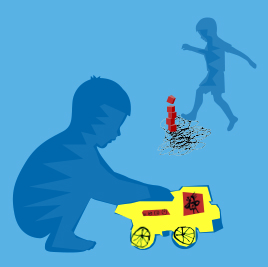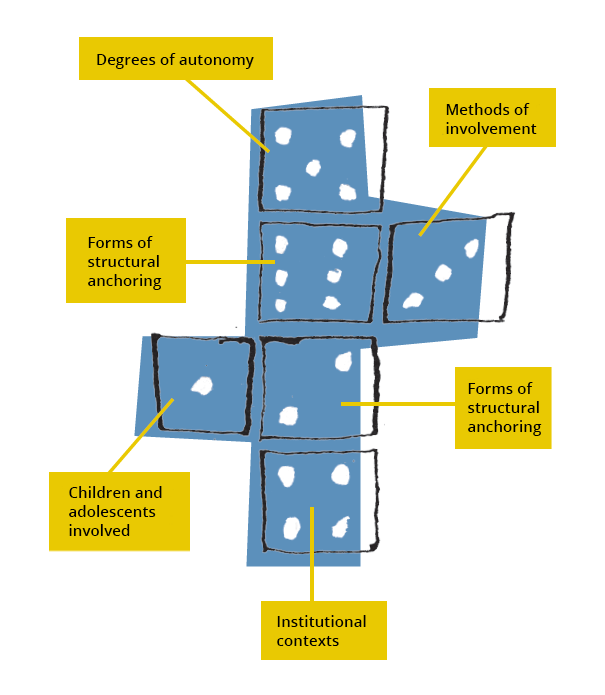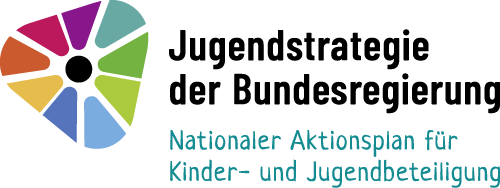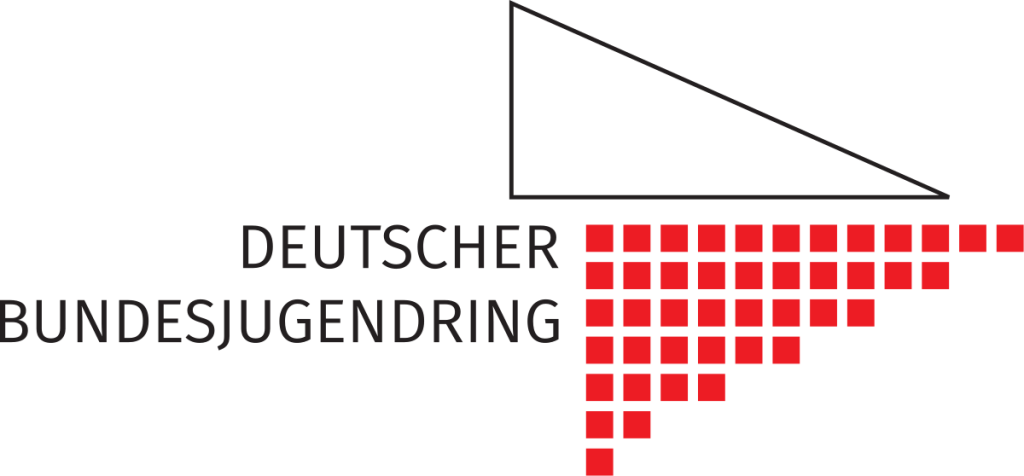
4. Models on involvement
There are a whole series of concepts in order to visualise the variety of forms of involvement. Again and again, we encounter models which portray the various forms of participation with the help of a staircase, a ladder or a pyramid (cf. e.g. Nanz/Fritsche 2012, p.23; Straßburger/Rieger 2019b, pp.12 et seqq.). Somewhat more complex processes use the image of a pyramid and also distinguish various perspectives, e.g. between involved citizens on the one hand and specialists, i.e. the institutional-professional perspectives, on the other hand.3
These models pursue a justified cause. Basically, they draw attention to the fact that there are not only differing forms of involvement, but that also great differences exist with a view to the question of the extent to which children and adolescents are rally involved, i.e. they are really granted highly effective possibilities of deciding and influencing. So it is a question of the distribution of power in the context of involvement processes and the question of the autonomy of the participants. In this way, some formats try to demarcate forms of “bogus participation”, of “alibi participation” or only symbolic or decorative participation from forms which grant children and adolescents influence and a decision-making power. Others distinguish between precursors of participation and “genuine”, “real” or “serious” participation. Simple forms of participation or “precursors” are for example informing children and adolescents about their rights and possibilities of influence or, for example, asking them about their opinions, wishes and expectations. All the models contain a number of intermediate phases.
As important as the cause of distinguishing various forms of participation under the aspect of influencing may be, three problems are simultaneously connected with these step concepts:
- almost all rising step models are based on a normative understanding of “real” participation. The step models really only recognise certain forms of participation, those with a high degree of self-determination and influence, and tend to make other variants quickly appear as immature precursors, which are always deficient in some way. They aim at a certain democratic ideal which is easy to substantiate, but run the risk of exposing all the other forms of participation, even where they possibly do not even intend to do so. But the fact that the apparently “low” steps often portray important possibilities of learning and experience as far as participation is concerned is thus lost from sight.
- the step models are mainly simple insofar as they only look at one dimension, i.e. the question of the division of power and the possibilities of influence. Other important aspects which are central for participation are not taken into account. To mention just one aspect, there is a great difference, particularly with a view to children and adolescents, whether you look at participation in the context of a kindergarten with children under 6, at a primary school with 9-year-olds or, for example, in youth work with 14-/15-year-olds. The same applies analogously if for example participation in connection with self-organised youth groups is compared with participation processes on a federal level. Both the institutional contexts as well as the preconditions on the part of children and adolescents are highly heterogeneous, which means that there is the need to distinguish participation formats under these perspectives as well.
- in the discussion about involvement, we all too easily forget that this is not only a right as an essential precondition for democracy and pedagogic practice, but also that it must be learned and trained like all other practices as well. Children and adolescents have a right to participation and are experts in their own affairs. At the same time, especially from a quality point of view, it must be considered that involvement requires settings matching the age and competences, if necessary accompaniment and support, so that not only excessive demand and disappointment are avoided, but so that they can learn from the experience. Above all with children and adolescents, participation processes are always connected with learning and education processes, which means that it is important to enable them accordingly. To pick the example up again, asking children’s and adolescents’ opinions and wishes can indeed be a suitable form and an important module of participation in the corresponding contexts against this background. In principle, the same applies to all other forms of participation.
This is expressly not a plea for the differing variants of bogus participation. But at the same time, when it is a question of the quality of participation, there is no option but to concern oneself more closely with the contexts, addressees, methods, contents and topics etc. in question – also to understand how these aspects interact in specific participation constellations. What we need are more differentiated concepts for description, analysis and sorting of various forms of participation of children and adolescents.
To visualise this, an important proposal was developed recently in Lüneburg by Waldemar Stange and his YouthPoliticsConsultancy team. His “participation cube”, which has been continuously further developed in recent years, is expressly understood as an analysis and dialogue instrument.4 At the same time, it is an invitation to all interested parties to approach the complexity of participation processes analytically, i.e. along central dimensions of participation. Essentially, the “cube” comprises three levels, which are termed as dimensions and which – and this is central for the understanding of the concept – supplement and penetrate one another, i.e. do not represent a hierarchy:
- On the highest level of the cube, the aspects of participation which have effects on the implications of participation processes are summarised. The fact that the children and adolescents who are involved, the differing fields of action inside which participation takes place, the objectives and claims of participation in question, the contents and topics in question and the methods used play a central role is directly comprehensible.5
- At the same time, on the front level of the cube – picking up the claim of the aforementioned step concept – participation formats are distinguished under the aspect of the degrees of autonomy and strength of the individual and collective influential strength. Unlike the step concepts, however, no implicit increase is underlying in this case of portrayal. No ideal top step to be aimed for and the efforts of the ladders in front of them are shown, but the centre point is shown by the interest in distinguishing context-related legitimate forms of participation. In its latest version, the cube distinguishes “weak, selective influence”, “indirect, advocatory participation (representation)”, “influencing by information rights, petition and complaint”, “involvement: co-management, co-production, consultation”, “co-determination – co-decision-making” and “self-administration – self-organisation – self-help”. The comparison with other concepts shows not only distinctions on the conceptual level, but also conceptional ones. For example, it is disputed whether complaint is a form of participation. But it is less the terms, which are not used in a standardised way anyway, which are essential at this point, but the idea of differing degrees of autonomy and possibilities of influence. Like the step models, only with hierarchical upward movement towards the ideal, the cube draws attention to the fact that there are great differences which are successful for the participation processes in question.
- On the third level, simultaneously the right-hand side of the cube, our view is turned to the varying forms of structural anchoring, bindingness and securing. Whereas the first three aspects, “legal anchoring”, “resources” and “political, social and cultural anchoring” move more structural, partly institutional moments into the centre point, the subject side is addressed with the aspect “psychological anchoring”.
For the understanding of the participation cube, it is of elementary importance that the aspects named are not understood as isolated analysis dimensions, but – at the same time in the interior of the cube – intersections result. Against the background of specific participation processes, the cube thus enables analysis of the constellations in question under the perspectives in question and making their complexity of intersections comprehensible. As W. Stange formulates it at one point, it is a question of an “agreement”, of the “production of a joint image”6, which means involvement in the specific case each time and how it is or has been designed. Quite expressly, W. Stange’s cube does not serve formulation of normative references about successful participation.
But precisely this is the cause of the quality standards for children and adolescents presented here. To do justice to this, a cube which is constructed somewhat differently and is highly simplified in comparison with the analytical concept of W. Stange is to be presented below. Against the background of the discussion in the subject, the model comprises six levels, which have proven to be essential precisely with a view to quality questions and which are repeatedly named in the texts contained in Section 6 on the differing fields of practice, albeit with a differing setting of accents. The six sides of the cube simultaneously represent dimensions on which the quality standards for participation of children and adolescents have to prove themselves:
Aspects of participation

The following are moved to centre of attention in this model:
- The children and adolescents involved, more precisely: the difference in the preconditions for participating on the children’s and adolescents’ part. It is therefore of central importance that, if one speaks of the quality of participation, not only the specific age, but also the differences resulting from the customary different categories (e.g. social origin, sexual orientation, gender, physical, mental and emotional competences, nature of handicaps, ethnic origin, ideology) are taken into account regarding their context, practice in the process and socially.
- The topics and contents of participation: only a gross overview of the various fields of action within which participation of children and adolescents takes place makes clear that very differing topics and contents are dealt with there. Participation in the design of a games afternoon in a day-care centre inevitably places different topics and contents on the agenda than for example involvement within the framework of a help plan process or participation in a communal children’s and adolescents’ parliament. However, one must not be seduced by these examples because each topic can be relevant for children’s and juveniles’ politics or can affect young people as a matter of principle. This heterogeneity of the topics and contents has the consequence under quality aspects that good participation must be orientated to the topics and contents and that specific institutional and procedural practice challenges are connected with this.
- The methods of involvement: the subject discussions and practices provide a number of methods, forms of work – also known as tools – for involvement.7 With the numerous digital platforms and apps, this spectrum has become considerably wider once more in the past 15 years without an end being in sight at the moment.8 All these processes are however tied to certain preconditions or are only sensible in certain thematic and institutional contexts. Under the perspective of quality, the question of what suitable involvement tools are under the conditions in question is therefore to be discussed under the perspective of quality.
- The institutional contexts: Just like topics and contents, the institutional contexts also vary, The three examples just named, day-care centre, help plan and Children’s and Adolescents’ Parliament make this exemplarily clear. The institutional contexts open up possibilities of involvement, but can block or limit them if applicable. A well-known example is school, where, at least with a view to teaching, the participation leeway for children and adolescents is relatively limited. In the present quality standards for children’s and adolescents’ involvement, this aspect plays a specific role insofar as its specification has been done along differing fields of practice up to now.
- The degrees of autonomy: the aspect of the differing degrees of autonomy of the children and adolescents involved is closely connected with the institutional contents, but is not to be equated to them. Essentially, this is the dimension which is most addressed in the aforementioned step models. Under quality aspects, it is the question of how much influence the involved children and adolescents have in each case. In cases of doubt, it does make a difference whether one is for example allowed to inform oneself, whether your own opinion is wanted, whether something like co-determination exists or actually the power to make decisions is handed on. A central role is finally played by the question of who actually decides on the rules of the participation. Under quality aspects, it is of decisive importance that these various leeways are discussed relative to the context, not abstractly.
- The forms of structural anchoring: One question is how involvement processes are organised and implemented relative to the children and adolescents involved and to the topics and contents, which leeways are opened or rejected; a quite different question is however what is done with the results of these involvement processes. Under quality aspects, the question of how the involvement processes are structurally anchored themselves is of importance: which obligations with a view to their results exist formally or informally, which obligations or even non-obligations have be entered into to concern oneself with the results, e.g. on the management area of an institution, in the communal parliament, in committees or planning processes? Anyone talking or thinking about the quality of involvement must also have an answer to this question.
To end this section, I would like to make two supplementary remarks:
- In the portrayal of the six sides of the involvement cube portrayed here, insertion of an internal differentiation, e.g. between differing groups of children and adolescents, between degrees of autonomy, between forms of anchoring, of the institutional contexts etc. was deliberately dispensed with. With a view to the variety of involvement constellations, either only very abstract categories could have been formed or a not very meaningful selection would have been made. In this way, the readers are invited to introduce and to sort their constellations. The fact that different sortings are done in this context, e.g. that inquiring about opinions is understood in the one context as a precursor of participation or possibly even bogus participation and that the same process appears as an indispensable variant of participation to be taken seriously in a quite different context, is to be seen in the logic of the portrayal chosen here.
- Although each of the six aspects in the model shown above is independent on its own, they are also to be read in the context with a view to the participation process in question. The metaphor of the cube is helpful in this regard insofar as it is easy to imagine how these aspects – also with regard to their inner distinctions just mentioned – cross at the same time in the interior of the cube. The quality questions are decided precisely at these “crossings” of the aspects in the specific case.
3 See for example: Straßburger/Rieger 2019, pp. 17 et seqq.; cf. also http://www.partizipationspyramide.de/; https://www.ljr-hh.de/index.php?id=675; Wolff 2016, p. 1054.
4 Cf. https://jugendpolitikberatung.de/wp-content/uploads/2022/04/Niveaustuf-u-Typen-Strkt-Verank-neu-4-2022-V3.pdf [status 10 April 2022].
5 The aspect of the “political cycles” presumably ought to be less familiar. This aspect taken from political science draws attention to the fact that political – one could generalise the aspect and say: all – decision processes pass through various phases. For example, Sonja Blum and Klaus Schubert distinguish the following phases in a widely distributed introduction to the analysis of political fields following a proposal by Werner Jann and Kai Wegrich: “Problem(Re)Definition”, “Agendasetting”, “Politics formulation” with subsequent decision, “Implementation” and “Politics Evaluation”, in order either to come to a close from there (Politics termination) or to redefine the problem (Blum/Schubert 2018, pp. 153 et seqq.; here above all p. 156). These phases are understood as a cycle and accordingly portrayed as a circle (cf. loc. cit.). If one follows such or similar models of politics, it is easy to understand that involvement in the phases in question means something very different. Whereas, for example, involvement at the start, to the extent successful, can have an influence on the problem definition and the stipulation of the agenda, it has completely different tasks and functions in the phase of implementation and transfer or, for example, in the phase of the subsequent assessment of success.
7 Cf. for example https://werkzeugbox.jugendgerecht.de/tool/beteiligung-leicht-gemacht-eine-uebersicht/; https://jugenddialog.de/do-it-yourself/toolbox/; https://mitwirkung.dbjr.de/; https://www.bjr.de/junggerecht/toolbox.html; https://www.servicestelle-jugendbeteiligung.de/materialien/.
8 Cf. for example https://tooldoku.dbjr.de/beteiligungswerkzeuge/; https://www.kinderrechte.de/beteiligung/starke-kinder-und-jugendparlamente/wissen-und-material/starke-kinder-und-jugendparlamente-digital/; https://www.kinder-jugendbeteiligung-sachsen.de/digitale-jugendbeteiligung/.



